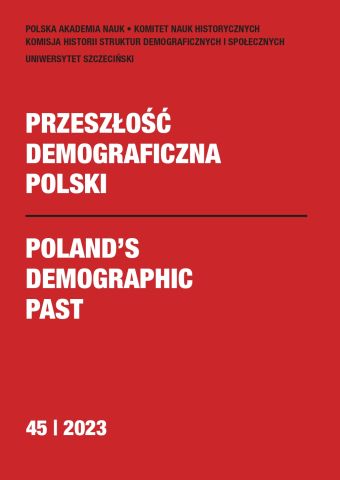








| Autorzy: |
Ján
Golian

University of Ss. Cyril and Methodius in Trnava, Slovakia Grażyna Liczbińska 
Instytut Biologii i Ewolucji Człowieka Wydział Biologii UAM |
| Słowa kluczowe: | Górne Węgry umieralność oczekiwane dalsze trwanie życia dobór naturalny tereny wiejskie epidemie |
| Liczba stron: | 27 (73-99) |
| 1. | Acsádi, György, and János Nemeskéri. History of Human Life Span and Mortality. Budapest: Akadémiai Kiadó, 1970. |
| 2. | Benedictow, Ole Jørgen. “Morbidity in Historical Plague Epidemics.” Population Studies 41 (1987): 401–31. |
| 3. | Bokesová-Uherová, Mária. Dejiny zdravotníctva na Slovensku. Martin: Osveta, 1989. |
| 4. | Bourdelais, Patrice. “Cholera: A Victory for Medicine?” In The Decline of Mortality in Europe, edited by Roger Schofield, David S. Reher, and Alain Bideau, 118–30. Oxford: Clarendon Press, 1991. |
| 5. | Cimmermannová, Eva. “Matrika ako historický prameň.” Historický časopis 22 (1974): 71–83. |
| 6. | Crow, James F. “Some Possibilities for Measuring Selection Intensities in Man.” Human Biology 30 (1958): 763–75. |
| 7. | Duncan, Stephen. R., Susan Scott, and Christopher J. Duncan. “Modelling the Dynamics of Scarlet Fever Epidemics in the 19th Century.” European Journal of Epidemiology 16 (2000): 619–26. |
| 8. | Ďurková, Mária. “Podpoľanie a najstaršie dejiny Detvy.” Historický časopis 47 (1999): 383–403. |
| 9. | Gieysztorowa, Irena. “Od metryk do szacunków ludności.” Kwartalnik Historii Kultury Materialnej 12 (1964): 283–98. |
| 10. | Gieysztorowa, Irena. Wstęp do demografii staropolskiej. Warszawa: PWN, 1976. |
| 11. | Gładykowska-Rzeczycka, Judyta. “Paleoepidemiologia-archeoepidemie.” Funeralia Lednickie 10 (2008): 37–52. |
| 12. | Golian, Ján. “Detva zahalená do smútku. Tri ničivé epidémie pustošiace mestečko v roku 1873.” In Pohromy, katastrofy a nešťastia v dejinách našich miest, edited by Michal Bada and Diana Duchoňová, 359–80. Bratislava: Igor Iliť–RádioPrint, 2019. |
| 13. | Golian, Ján. “Possibilities of Studying Epidemics of Cholera in Upper Hungary (Contemporary Slovakia) in the 19th Century.” Studia Historiae Oeconomicae 40, no. 1 (2022): 61–78. |
| 14. | Golian Ján. Život ľudu detvianskyho. Ružomberok: The Society for Human Studies, 2019. |
| 15. | Golian, Ján, and Grażyna Liczbińska. “The Influence of Extreme Exogenous Shocks on the Sex Ratio at Birth: A Study of the Detva Population (Upper Hungary), 1801–1920.” Romanian Journal for Population Studies 16, no. 2 (2022): 27–52. |
| 16. | Haines, Michael R. “Population and Economic Change in Nineteenth-Century Eastern Europe: Prussian Upper Silesia, 1840–1913.” Journal of Economic History 36 (1976): 334–59. |
| 17. | Henneberg, Maciej. “Notes on the Reproduction Possibilities of Human Prehistorical Populations.” Przegląd Antropologiczny 41 (1975): 75–89. |
| 18. | Henneberg, Maciej. “Reproductive Possibilities and Estimations of the Biological Dynamics of Earlier Human Populations.” In The Demographic Evolution of Human Populations, edited by Richard. H. Ward, and Kenneth. M. Weiss, 41–8. London: Academic Press, 1976. Academic Press, 1976. |
| 19. | Henneberg, Maciej, and Janusz Piontek. “Biological State Index of Human Groups.” Przegląd Antropologiczny 41 (1975): 191–201. |
| 20. | Holzer, Jerzy Z. Demografia. Warszawa: Państwowe Wydawnictwo Ekonomiczne, 1970. |
| 21. | Johansson, Kent. Child Mortality during the Demographic Transition: A Longitudinal Analysis of a Rural Population in Southern Sweden, 1766–1894. Lund: Lund University Press, 2004. |
| 22. | Maur, Eduard. “O počátcích a vývoji cirkevních matrik se zvláštním zřetelem k českým poměrům.” Historická demografie 3 (1969): 4–19. |
| 23. | Mielke, James H., and Alan G. Fix. “The Confluence of Anthropological Genetics and Anthropological Demography.” In Anthropological Genetics: Theory, Methods and Applications, edited by Michael H. Crawford, 112–40. Cambridge: Cambridge University Press, 2012. |
| 24. | Landers, John. “Historical Epidemiology and the Structural Analysis of Mortality.” Health Transition Review 2 (1992): 47–75. |
| 25. | Landers, John. Death and the Metropolis: Studies in the Demographic History of London 1670–1830. Cambridge: Cambridge University Press, 1993. |
| 26. | Liczbińska, Grażyna. “Ecological Conditions vs. Religious Denomination: Mortality among Catholics and Lutherans in Nineteenth-Century Poznań.” Human Ecology 39 (2011): 795–806. |
| 27. | Liczbińska, Grażyna. “Infant and Child Mortality among Catholics and Lutherans in Nineteenth Century Poznań.” Journal of Biosocial Science 41 (2009): 661–83. |
| 28. | Liczbińska, Grażyna. Lutherans in the Poznań Province: Biological Dynamics of the Lutheran Population in the 19th and Early 20th Centuries. Hamburg: Verlag Dr. Kovač, 2015. |
| 29. | Mackenbach, Johan P., and Caspar W. N. Looman. “Secular Trends of Infectious Disease Mortality in the Netherlands, 1911–1978: Quantitative Estimates of Changes Coinciding with the Introduction of Antibiotics.” International Journal of Epidemiology 17 (1988): 618–24. |
| 30. | Pitkänen, Kari J., James H. Mielke, and Lynn B. Jorde. “Smallpox and Its Eradication in Finland: Implications for Disease Control.” Population Studies 43 (1989): 95–111. |
| 31. | Podrimavský, Milan, Dušan Kováč, and Palo Hapák. Dejiny Slovenska IV (od konca 19. Storočia do roku 1918). Bratislava: Veda, 1986. |
| 32. | Preston, Samuel H., and Michael R. Haines. Fatal Years: Child Mortality in Late Nineteenth–Century America. Princeton, NJ: Princeton University Press, 1991. |
| 33. | Pulzijević, Kristina. “Managing the Epidemics in 19th Century Dalmatia: From Fatherly Monarch to Scientific Grounds.” Historical Social Research Supplement 33 (2021): 79–99. |
| 34. | Pressat, Roland. Analiza demograficzna: metody, wyniki, zastosowania. Warszawa: PWN, 1961. |
| 35. | Preston, Samuel H., and Etienne van de Walle. “Urban French Mortality in the Nineteenth Century.” Population Studies 32 (1978): 275–97. |
| 36. | Sułowski Zygmund. “O właściwą metodę wykorzystywania metryk koscielnych dla badań demograficznych.” Kwartalnik Historii Kultury Materialnej 1–2 (1862): 81–101. |
| 37. | Szeghy-Gayer, Veronika. “The Second Wave of the Spanish Influenza Pandemic in Selected Regions and Towns of Slovakia (1918).” Individual and Society/ Človek a spoločnosť 25, no. 2 (2022): 1–12. |
| 38. | Tišliar, Pavol, and Branislav Šprocha. Premeny vybraných charakteristík obyvateľstva Slovenska v 18.–1. pol. 20. storočia. Bratislava: Muzeológia a kultúrne dedičstvo o.z.; Centrum pre historickú demografiu a populačný vývoj Slovenska FiF UK v Bratislave, 2017. |
| 39. | van Poppel, Frans, Marianne Jonker, and Kees Mandemakers. “Differential Infant and Child Mortality in Three Dutch Regions, 1812–1909.” Economic History Reviews 58 (2005): 272–309. |
| 40. | Vögele, Jörg. “Cholera, Pest und Innovation.” Pandemie 6 (2020): 22–5. |
| 41. | Vögele, Jörg. Urban Mortality Change in England and Germany, 1870–1913. Liverpool: Liverpool University Press, 1998. |
| 42. | Vögele, Jörg. “Urbanization and the Urban Mortality Change in Imperial Germany.” Health & Place 6 (2000): 41–55. |
| 43. | Vögele, Jörg, Luisa Rittershaus, and Katharina Schuler. “Epidemics and Pandemics – The Historical Perspective: Introduction.” Historical Social Research. Supplement 33(2021): 7–33. |
| 44. | Watson, Robert. “Whooping Cough: A Brief History to the 19th Century.” Canadian Bulletin of Medical History 29 (2012): 329–49. |
| 45. | Williams, Naomi, and Chris Galley. “Urban-Rural Differentials in Infant Mortality in Victorian England.” Population Studies 49 (1997): 401–20. |
| 46. | Wolleswinkel-van den Bosch, Judith H., Caspar W. N. Looman, Frans W. A. van Poppel, and Johan P. Mackenbach. “Cause-Specific Mortality Trends in The Netherlands, 1875–1992: A Formal Analysis of the Epidemic Transition.” International Journal of Epidemiology 26 (1997): 772–81. |
| 47. | Wolleswinkel-van den Bosch, Judith H., Frans W. A. van Poppel, Caspar W. N. Looman, and Johan P. Mackenbach. “Determinants of Infant and Early Childhood Mortality |
| 48. | Levels and Their Decline in the Netherlands in the Late Nineteenth Century.” International Journal of Epidemiology 29 (2000): 1031–40. |
| 49. | Wolleswinkel-van den Bosch Judith H., Frans W. A. van Poppel, Ewa Tabeau, and Johan P. Mackenbach. “Mortality Decline in the Netherlands in the Period 1850–1992: A Turning Point Analysis.” Social Science & Medicine 47 (1998): 429–43. |
| 50. | Wolleswinkel-van den Bosch, Judith H., Frans W. A. van Poppel, Caspar W. N. Looman, and Johan P. Mackenbach. “The Role of Cultural and Economic Determinants in Mortality Decline in the Netherlands, 1875/1879–1920/1924: A Regional Analysis.” Social Science & Medicine 53 (2001): 1439–53. |
| 51. | Woods, Robert. “Public Health and Public Hygiene: The Urban Environment in the Late Nineteenth and Early Twentieth Centuries.” In The Decline of Mortality in Europe, edited by Roger Schofield, David S. Reher, and Alain Bideau, 233–47. Oxford: Clarendon Press, 1991. |
| 52. | Woods, Robert. I., Patricia A. Watterson, and John H. Woodward. “The Causes of Rapid Infant Mortality Decline in England and Wales, 1861–1921 Part I.” Population Studies 42 (1988): 343–66. |
| 53. | Woods, Robert. I., Patricia A. Watterson, and John H. Woodward. “The Causes of Rapid Infant Mortality Decline in England and Wales, 1861–1921. Part II.” Population Studies 43 (1989): 113–32. |
| 54. | Zemko, Ján et al. Detva. Martin: Osveta, 1988. |
| 55. | Žudel, Juraj. “Administratívne členenie územia Slovenska za dualizmu (1867–1918).” Slovenská archivistika 28 (1993): 79–80. |